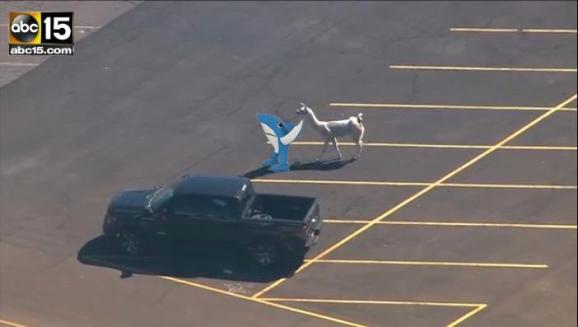
OPINION:
For about two hours today, all the Internet wanted to talk about was the FCC’s historic net neutrality decision. (They’re in favor of it.)
Then, suddenly, all work stopped as the digerati focused their collective attention on two runaway llamas scampering around Phoenix.
Short attention span much? Sure. Never accuse the Twitterverse of being able to focus on any one thing for very long. And if it involves cute animals, a skycam, or — wonder of wonders — both of those things, well, it’s hard for those of us brought up in the school of quick clicks to resist.
But the two events are more connected than you might think. Without belaboring the point too much, it’s clear that the Llama Drama could never have happened without a fairly substantial stack of technologies, all working together smoothly.
Helicopters? Check. High-bandwidth, real-time digital video connections from the helicopter to the TV station? Check. A social network primed to share links (and jokes) about an entertaining, developing “news” situation as it happens? Check.
The ability for a local TV station in Phoenix to broadcast live video anywhere in the world, in real time, with a minimum of lag and pretty decent video quality? Check.
Now imagine a world where that TV station wasn’t able to broadcast real-time HD video without paying extra fees. Where Netflix, because it had paid extra fees to your ISP, could guarantee that you’d be able to watch the upcoming release of House of Cards season 3 without hiccups, but at the expense of the live video feed from ABC 15 in Phoenix. Where ABC 15 couldn’t even be sure its video feed would get across at all, because it hadn’t made extra payments to every ISP and content delivery network along the path from its servers to your browser.
Now, this argument works for both sides of the net neutrality debates. The FCC just made its decision today, but as of today’s Llamapalooza, those rules were not yet in effect.
ISPs and wireless carriers — starting with Verizon — have mocked the FCC for trying to apply ancient, 1930s-era communications policy to the modern world’s technologies. And we were all able to watch the llamas without an explicit net neutrality mandate just fine, thank you very much.
But net neutrality proponents point out that there are plenty of examples already where carriers have prioritized the content of paying customers over others. It’s only a matter of time, the argument goes, until you can’t get through to customers in any kind of reasonable way without paying extra. Just because you could watch Llamarama today doesn’t mean it’ll be streaming smoothly the next time it happens — and that’s why we need regulatory enforcement.
As for me, I can see both sides of the argument, but I feel there’s a strong argument to be made for the FCC to ensure that everyone — individual consumers as well as small-time video broadcasters — have access to a basic level of service. That shouldn’t eliminate the option for companies like Netflix to hire CDNs to ensure fast, timely delivery — as long as that priority channel doesn’t adversely affect the transmission of basic email, web content, and video.
In other words, as FCC chairman Tom Wheeler said today, this isn’t a restrictive regulatory move (unless you’re a rapacious carrier). This is a guarantee of non-restriction.
“This is no more a plan to regulate the Internet than the First Amendment is a plan to regulate free speech!” Wheeler said today, nearing yelling.
As for the llamas: Well, they’ve now been regulated. Both were eventually lassoed, bringing an end to the epic that future generations might call the Llamayana.
We mourn. But, like the Left Shark, the images of the llamas will live on. And so will the Internet.
from VentureBeat » Dylan Tweney http://ift.tt/18rYsYm
